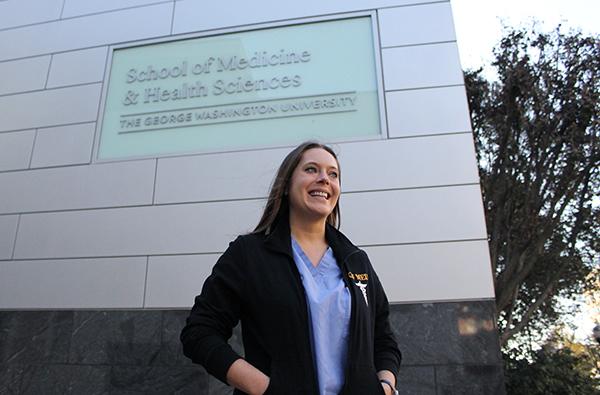GW may be asking for contributions to its $1 billion fundraising campaign, but there’s one department looking for donors to give the ultimate gift: their bodies.
The University’s body donor program helps first-year medical students learn anatomy beyond what a textbook can teach, becoming part of a student’s “rite of passage” at the school. And though GW is an outlier among medical schools nationwide, many of which do not have students work with donated cadavers, the number of body donors has increased 80 percent over the past two years.
About 800 more people have signed up to give their bodies to the University over the past two years, which makes the total number of donors on the list top 1,800.
Anne Banner, the director of communications at the School of Medicine and Health Sciences, said there is no active recruitment for body donors and most people sign up for the program because they are aware of the need for cadavers for teaching.
The Body Donor Program, which resides in the department of anatomy and regenerative biology at SMHS, helps GW stand out from other medical schools: It is one of 130 schools in the country with a body donation program, but does not accept bodies from other sources, such as morgues.
“People hear about it from others, or they may be actively looking to donate their bodies,” said Janette Krum, an associate professor who teaches anatomy at the medical school. “They find us on the web or call the anatomy department office to inquire about the program or to make arrangements to donate.”
If donors’ bodies do not reach the school’s standards, they are declined. Bodies are only accepted if the person has died within a 50-mile radius of the program. Other factors, including diagnoses of communicable diseases like HIV or AIDS, any recent surgery or obesity, can lead to bodies not being included.
While many people donate their organs, less than 1 percent of the general population donate their bodies to science.
Other medical schools will sometimes use unclaimed or unidentified bodies from local morgues, but D.C. has no official system to allow those bodies to be used for medical studies, Krum said.
Professors and medical students say the program helps them better prepare to work in a hospital setting. Even though GW offers its students opportunities to learn with virtual tools or dummies, like in its simulation center that expanded earlier this year, there is still a heavy emphasis on practicing with cadavers to gain a realistic understanding of the human body.
“The idea of studying a cadaver is as old as studying medicine,” said fourth-year medical student Jamie Adler. “It’s a fundamental part of understanding the human body.”
Anne Hirshfield, a professor of anatomy, also said dissection of actual human bodies is a crucial part of the learning experience for medical students.
“Physicians have to learn how to have a relationship that other people don’t have. They need to touch and be intimate with bodies,” Hirshfield said. “It’s a process of transforming them into physicians who can have professional relationships with the body.”
Body donor programs can be found at other universities across the country as well, including Vanderbilt and Stanford universities.
“With computers we can’t get the hands on the tissues and get fingers on the muscles. We can’t see into the chest cavities,” said Chris Dolph, the coordinator for Stanford’s Willed Body Program. “It’s better to get your hands on. Everything isn’t the same as it is in the textbook.”
Unlike most other university donor programs, including GW, UCLA does accept people who have been organ donors.
“We try and honor their gift by using every little inch of the body to learn with,” said Dean Fisher, director of the donated body program at UCLA. “We can still use limbs for orthopedics, so we would ask the family. If they’re willing to donate, we’re willing to accept – it might be used for surgical instruction.”
Fisher added that the program tries to spread awareness through word of mouth, visiting hospice meetings and nursing homes.
GW cremates the bodies once studies are completed, typically 24 to 36 months from the time of death, and returns the ashes to the donor’s family. In the spring, a special memorial service is held for the families of body donors to show gratitude and celebrate the lives of the donors.
Kurt Johnson, a professor in the anatomy department since 1977, said he plans to donate his own body to science, but not to GW.
“Economically, it makes sense. You can spends thousands and thousands of dollars getting buried, and this is a cost-free way to account for your remains. In my view, it’s sort of a waste of resources to bury you in a box somewhere or in a graveyard,” he said. “I wouldn’t donate my body to GW because some of my colleagues would see me laying out there on the slab.”







